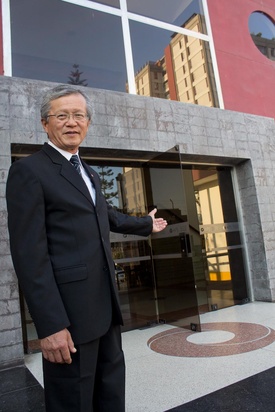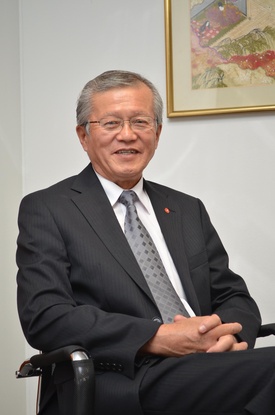In May, the Peruvian Japanese Cultural Center (CCPJ) celebrated its 50th anniversary. In a few months, the Peruvian Japanese Association (APJ) will commemorate 100 years of existence. A singular coincidence that makes 2017 a significant year for the Nikkei community in Peru.
While the APJ is the governing institution of the community, the CCPJ is the physical space in which it develops its cultural and institutional activities. Since its foundation, it has been the main disseminator of Japanese culture in Peru.

What better opportunity than a double round anniversary to look back at the past and value the work of those who laid the foundations. Jorge Yamashiro, former president of the APJ and tireless cultural promoter, highlights that the 50th anniversary of the CCPJ has allowed many to learn the history of how it was created and materialized.
The CCPJ was inaugurated on May 12, 1967 in a ceremony that included the participation of the then princes Akihito and Michiko. An achievement that had many parents and a long incubation period. It was possible thanks to the Japanese immigrants who conceived the idea, put it into action, traveled to Japan in search of financial support and carried out high-level negotiations, one of the main fruits of which was the delivery of land, in 1965, by the government of Peru to the Japanese colony in compensation for the Japanese schools that the Peruvian authorities confiscated during World War II. The CCPJ was built on that ground.
The Issei did all this work voluntarily, even from their own pockets. “There was an ideal that they followed: the union and development of the Nikkei community,” says Jorge Yamashiro, better known within the community as Akira.
The Nikkei leader highlights the continuous work of the successive leaders of the Central Japanese Society (as the APJ was previously called) over the years, the accumulation of efforts towards the same goal: the construction of the CCPJ.
For someone unfamiliar with the history of Peru, this might be surprising: isn't it the most logical thing to do to put one brick on top of another, to continue the work of our ancestors, to build on what they built? Yes, but that was not the norm during much of the history of contemporary Peru, where each leader came to power to retrace what had been done and create his own path.
Contrary to what was happening in the country, the community was always clear about where it was going and all its efforts converged in the same direction. Therefore, the replacement of some leaders by others did not imply the demolition of what had been done before, but rather its continuation.
Akira maintains that what characterizes the Peruvian Nikkei is their homogeneity, the fact that there was no mass migration of Japanese after World War II, unlike other South American countries such as Argentina or Brazil. The community was formed with the spirit and mentality of Japan in the first decades of the last century, different from those of the post-war period.
This homogeneity, to which the fact that the majority of immigrants came from the same prefecture (Okinawa) also contributed — Akira points out — has been key for the Nikkei to always row in the same direction, since there is consensus on the route to follow. continue, ensuring the continuity of policies and works.
He mentions what happened in the 1980s, when there was a generational change and institutional management migrated from the Issei to the Nisei, a smooth transition in which respect for elders, a common practice in the community, had a lot of weight.
Another aspect that Akira highlights is the strong sense of communion of the Nikkei, inherited from the Issei, who since they arrived in Peru have associated to support each other. He cites as an example the three Nikkei savings and credit cooperatives, which capture the spirit of immigrants and are the largest in Peru.
NIKKEI BRAND

The APJ has achieved economic stability – says its former president – which “allows it to unify and lead the community.” With the resources generated by the health and education units, the institution can carry out cultural and social assistance activities.
Cultural activities that take place at the CCPJ, which seeks to open itself more and more to society in general. If twenty or more years ago it was difficult for a person of non-Japanese origin to enter the CCPJ, due to the perception that “only Jaladitos entered,” now it is “completely the opposite,” explains Akira.
Its facilities host a wide variety of events: plays, art exhibitions, dance shows, musical shows, film screenings, conferences (on various topics: history, literature, health, etc.) and gastronomic festivals, among others.
Recruiting Nikkei young people, attracting them to the CCPJ so that they find there a space to develop and disseminate their work, their skills and knowledge, is important for the institution. Thus was born the First Nikkei Young Art Salon, which brought together ten Nikkei artists under thirty years of age to exhibit their works in a group exhibition that has had extensive media coverage in Peru.
The success of the exhibition, says Akira, is based on the work of the predecessors of these young people, nisei like Tilsa Tsuchiya and Venancio Shinki or sansei like Haroldo Higa and Aldo Shiroma . Just as at the institutional level there is a heritage that is maintained and grows, the same happens in areas such as the artistic field.
Akira maintains that the CCPJ can be important for young Nikkei people not only from an artistic or professional point of view, but also to connect with their roots, get closer to their history, know where they come from, who their ancestors were and, in this way , understand themselves better. He speaks from his own experience.
“I am Nisei, and when I was young it is not that I suffered like in the war, but I have felt the impact in terms of my own behavior compared to the behavior of all Peruvians in general. I have studied in a national school, and one was always calm, quiet, low profile. Sometimes one would say 'why?'. Just being here, seeing a little history, I say 'ah, that's why I'm like this, that's how they raised me, our parents kept us like this, with a low profile', (they told us) 'don't get involved', and one reconciles with their behavior.”
Strengthening the image of Nikkei, making it a kind of quality seal, a guarantee mark, is another of the tasks that he considers fundamental.
Akira Yamashiro currently directs the APJ Editorial Fund , which seeks to perpetuate in books the history of Japanese immigration to Peru and the contribution of the Nikkei to the development of the country.
Two Nisei were the winners of the first competition organized by the Fund. Both told the stories of their immigrant parents, one set in Cusco and the other in the Amazon.
An additional task in his long experience in the APJ. A leadership task that entails rigor and responsibility, without a doubt; However, that does not stop me from enjoying doing it. “I feel like a fish in water,” he says. “When you like it, you don't care about the time or anything, you hesitate.”
© 2017 Enrique Higa





